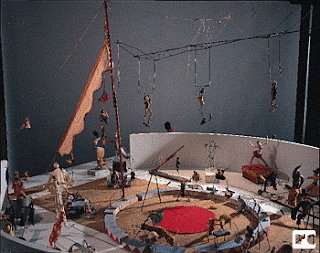Paul Klee at the Phillips Collection

George Calinescu about Liviu Rebreanu: any sentence of him is like keeping some sea water in your hand: colorless and tasteless - but a couple of pages have the din and the struggle of ocean. Two great figures in the Romanian literature, a historian and a novelist, Calinescu and Rebreanu.
Calinescu's words about Rebreanu came into my mind as I was visiting the exhibition of Paul Klee at Phillips Collection. I had seen before a couple of Klee's works, now I was surrounded by tens and tens. The impression was overwhelming.
Hoffmanesque Geschichte, Das Tor zum Hades, Stadt im Zwischenreich, Abstract Trio, Die Angler... Sometimes the grace to be found later at Calder, sometimes a finesse of cloisoneé. Schulhaus and Dorf - Carnaval were reminding me of Chagall.

A painting from 1926, Die Ankuft der Gaukler (The Arrival of Jugglers) brought into my mind the Circus of Calder. The painting of Klee was of course bidimensional, only it gave a spatial feeling, like the sculptural work of Calder. What was marvelous, the spatial feeling in the painting of Klee was not coming from a traditional technique of perspective - his work was organized rather on the way followed by Byzantine icons.
The painting of Klee had in all a diaphanous aspect, like any of his works. I was retrieving this delicacy on each juggler from Calder's Circus.

Negroid Beauty, a surprinsingly classical work of Klee... Kalte Stadt... Tropische Garden Kultur... Schreck eines Maedchen... Eulenkomoedie, like an overexposed photo... Elephant and Lion (reminding me of Tuculescu)... Oriental Pleasure Garden... Sacred Islands... Kleines Regattabill, white little boats that seem like paper made... The Path into the Blue...
Like other great abstractionists, Klee was looking for something beyond the visible. Malevich or Mondrian tried to find the transcendent by using geometry. Klee followed another way. He was persuaded by the idea that a spontaneous eye could see what's hidden beyond what we see. And this spontaneity can be found if we understand the way primitives and kids look at the universe.You know the famous remark of Picasso, when I was at the age of these children I could draw like Raphael. It took me many years to draw like them. A friend of mine, a Romanian artist working in Chicago, Larry Bonn Phoenix said once that in his simple drawing any kid is trying to communicate to us the essential, in the universal language - and we never understand him.
Klee tried all his life to discover what primitives knew and what kids try each time to communicate to us.

0 Comments:
Post a Comment
<< Home